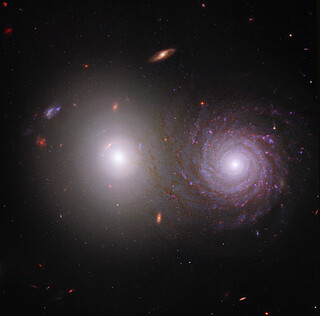Galaxy
A galaxy is a ensemble of stars, dust, gas and dark matter that are bound together by gravity. Galaxies contain anywhere between a few hundred million to a hundred trillion stars.
Galaxies are collections of stars, dust, gas, and dark matter, which are bound together by the gravitational attraction that results from their own mass. A small dwarf galaxy contains a few million stars, whilst the biggest known galaxies can contain up to a hundred trillion stars. There are many different galaxy morphologies, including elliptical galaxies and spiral galaxies. Many galaxies, including the Milky Way, have supermassive black holes at their centres. If the black hole is active, then the galaxy’s active core is classified as an active galactic nucleus (AGN). Galaxies are highly dynamic, evolving considerably throughout their lifetimes and interacting with one another. As they are so large and bright, it is possible to study galaxies that are extremely far away — galaxies more than 13 billion light-years distant from Earth have been observed. The speed of light is finite, meaning that, for example, if a galaxy 13 billion light-years away is observed, it is seen how it was 13 billion years ago. This makes the study of galaxies a fascinating opportunity to study ‘fossils’ from the history of the Universe, thus providing clues to how the Universe has evolved over time.
Webb is able to observe galaxies in infrared light. The light from the extremely distant galaxies in the early Universe has been stretched out to infrared wavelengths over its journey, as a result of the expansion of the Universe; this makes infrared astronomy the best technique to study the very first galaxies. With its highly sensitive near- and mid-infrared instruments, Webb will capture the light from more distant galaxies than have ever been seen before.
Webb has already set a new milestone in the quest for distant galaxies that date back to less than 400 million years after the Big Bang. As astronomers undertake more ambitious observations with the telescope and are able to perform follow-up observations and review spectroscopic data, we expect to see galaxies at even earlier times in the history of the Universe.
Webb's sensitive instruments have also proven extraordinarily productive in picking out galaxies: this deep-field image of Abell 2744 is crowded with the hundreds of elliptical galaxies that make up the cluster.
You can see some of Webb's images of distant and beautiful galaxies here.




